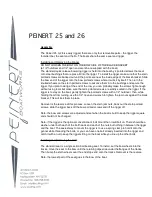
2021 OWNER’S MANUAL | Safety
7
from the switch. You should not be able to restart the engine
until the lanyard is back in place.
Personal Flotation Devices
Federal law requires that you have at least one wearable
Personal Flotation Device (PFD) of the proper size (Type I,
II, III, or V) for each person on board or being towed, and at
least one throwable PFD (Type IV) in the boat. PFDs must be
Coast Guard approved, in good and serviceable condition, and
the appropriate size for the user. To meet requirements, each
lifesaving device must have a current, legible USCG approval
stamp permanently affixed. At the beginning of each season,
inspect PFDs for damage and test for proper flotation. Refer to
the PFD manufacturer’s information.
REMEMBER – The best PFD is the one that is worn – that
is, the one that can save your life.
PFDs are intended to save
lives; it is highly recommended that you and your passengers
wear them while in the boat. Learn how to use them and
adjust as necessary for comfort. It is especially important that
children and non-swimmers always wear a PFD. Make certain
all passengers know where life jackets are located, how to put
on and properly adjust their PFD, and that PFDs are always
accessible.
Your dealer can help you select appropriate PFDs and
throwable lifesaving devices for your area. Some PFDs are
specially made for use while water skiing or wakeboarding and
are not USCG approved. Please check local law with respect
to their use. Some states require children to wear a PFD at all
times. There are four types of wearable PFDs (Type I, II, III, or V)
and one throwable type of PFD (Type IV) used for throwing in
emergency situations. Examples of these USCG approved PFDs
are shown:
Type I – Offshore Life Jacket:
This PFD
is designed for extended survival in rough,
open water. It will usually turn an unconscious
person face up and has over 22 pounds of
buoyancy. This is the best PFD to keep you
afloat in remote regions where rescue may be
slow in coming.
Type II – Near Shore Buoyant Vest:
This
“classic” PFD comes in several sizes for adults
and children and is for the calm inland water
where there is chance of fast rescue. It is less
bulky and less expensive than a Type I, and
many will turn an unconscious person face up
in the water.
Type III – Flotation Aid:
These PFDs are generally considered
the most comfortable, with styles for
different boating activities and sports. They
are for use in calm water where there is a
good chance of fast rescue since they will
generally not turn an unconscious person face
up. Flotation aids come in many sizes and
styles.
Type IV – Throwable Device:
These are designed to be
thrown to a person in the water. Throwable
devices include boat cushions, ring buoys, and
horseshoe buoys. They are not designed to be
worn and must be supplemented by wearable
PFD. It is important to keep these devices
immediately available for emergencies.
Type V – Special Use Device:
Special
use PFDs include work vests, deck suits, and
hybrids for restricted use. Hybrid vests contain
some internal buoyancy and are inflatable to
provide additional flotation. These PFDs may
be used instead of a Type I, II, or III PFD with
non-towed participants if used in accordance
with the approval conditions on the label and if
worn when the boat is underway. Some Type
V PFDs provide increased protection against hypothermia.
Fire Extinguisher
A portable fire extinguisher is required if your boat has
an inboard engine, or when fuel is stored in closed stowage
compartments.
Approved fire extinguishers are classified by a letter symbol,
either B-l or B-ll with the B designating that the material will
extinguish flammable liquids such as gasoline, oil, etc. B-l
extinguishers are required for boats less than 26 feet in length.
NOTICE
A Type V PFD must be worn to be counted toward the minimum
carriage requirements.
NOTICE
Special life jackets are available for skiing and other water sports.
These non-Coast Guard approved life jackets do not count as PFDs.
Summary of Contents for RESPONSE TXi 2021
Page 1: ...OWNER S MANUAL 21...
Page 2: ...This page has been intentionally left blank...
Page 4: ......
Page 14: ......
Page 15: ...2021 OWNER S MANUAL Safety 1 SAFETY...
Page 29: ...2021 OWNER S MANUAL Safety 15...
Page 42: ...28 Safety 2021 OWNER S MANUAL...
Page 66: ...52 Quick Reference Guide 2021 OWNER S MANUAL...
Page 67: ...2021 OWNER S MANUAL Dashes Video Screens 53 DASHES TOUCH SCREENS...
Page 94: ...80 Dashes Video Screens 2021 OWNER S MANUAL...
Page 95: ...2021 OWNER S MANUAL Engines Drive Trains 81 ENGINES DRIVE TRAINS...
Page 108: ...94 Engines Drive Trains 2021 OWNER S MANUAL...
Page 109: ...2021 OWNERS MANUAL How It Works 95 HOW IT WORKS...
Page 130: ...116 How It Works 2021 OWNERS MANUAL...
Page 131: ...2021 OWNERS MANUAL Trailers 117 TRAILERS...
Page 146: ...132 Trailers 2021 OWNERS MANUAL...
Page 147: ...2021 OWNER S MANUAL Get Ready 125 GET READY...
Page 154: ...132 Get Ready 2021 OWNER S MANUAL...
Page 155: ...2021 OWNER S MANUAL Care Maintenance 133 CARE MAINTENANCE...
Page 174: ...152 Care Maintenance 2021 OWNER S MANUAL...
Page 176: ...154 Care Maintenance 2021 OWNER S MANUAL...
Page 177: ...2021 OWNER S MANUAL Warranty 155 WARRANTY...
Page 178: ...156 Warranty 2021 OWNER S MANUAL...
Page 191: ...2021 OWNER S MANUAL Warranty 169 Date Date Date Date Date Date Date Date...
Page 200: ...This page has been intentionally left blank...
Page 202: ......
















































